Panzerjägerwagen (Panzerzug BP42/44)
 Nazi Germany - About 20 to 30 made.
Nazi Germany - About 20 to 30 made.
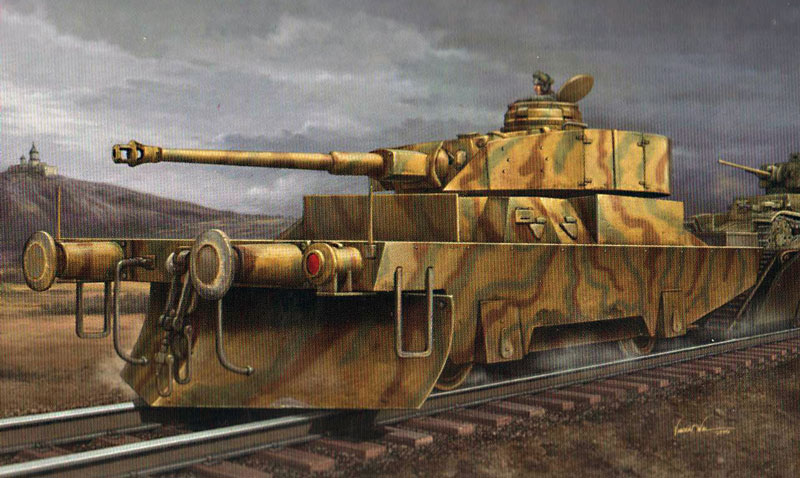
Artist depiction of the Panzerjägerwagen
On our case, there was a specific type of rail-mounted Panzer-IV turret, called several names, Panzerwagen IV auf Zugwagen, or even "panzerzug IV" for simplification, but also Panzerjägerwagen IV, and Panzerjägerwagen des BP44 when attached to a BP 44 armoured train. It was a specific unpowered head railroad car on two axles, usually mounted a massive dozer blade forward, and thus often mounted at the head of an armoured train.
Its story is linked to the various German armoured trains used during the war: Eisenbahn-Panzerzüge Typ BP42 and BP44.
Eisenbahn-Panzerzüge BP42/44
The BP42 (PZ No.61-72) comprised 130 men as crews and were purely combat trains, structured symmetrically. In the middle was the armored locomotive with an armored tender at the front and rear. Each halves comprised a gun carriage, infantry or command car, one artillery and FLAK car with 2cm Flakvierling, one ro-ro armored carrier car with Panzer 38 (t) and a push-off truck.The BP44 was introduced in 1944 as an improved BP42 (Panzerzug no.73-84). The PZ 38 and PZ 84 cars were removed. The push-off vehicle was replaced by the Panzerjägerwagen, a tailored car equipped witha tailored armour and topped with a Panzer IV turret with the 7.5cm KwK L/48 as main gun (So Panzer IV ausf H). However, not all BP42s were retrofitted with the Panzerjägerwagen. Some BP.42 were also retrofitted with a 10.5cm or 15cm field howitzer car.
The BP42 and BP44 could deploy also two (Panhard 178) Panzerspähwagen P204(f) armored reconnaissance cars, to explore freely the surroundings and convertible to tracks as Schienenpanzer 204(f) with the help of conversion kits carried on the push-off cars. Standardization could not be maintained as the war continued and resources dwindled.
Numerous sub-variants appeared, with a simplification in the composition, and the 2cm flakverling replaced by simpler whirlwind turrets. The eastern front train 26 was converted in 1944 with two captured T34 turrets. Panzerzug 27 carried two Somua S35 medium tanks, with the possibily of dismounting them. In 1943, Saurer-Werke in Vienna was order to develop an armoured railway car to fit a Panzer III turret, but it stayed at paper stage.
About the PanzerJägerwagen IV (Zug)
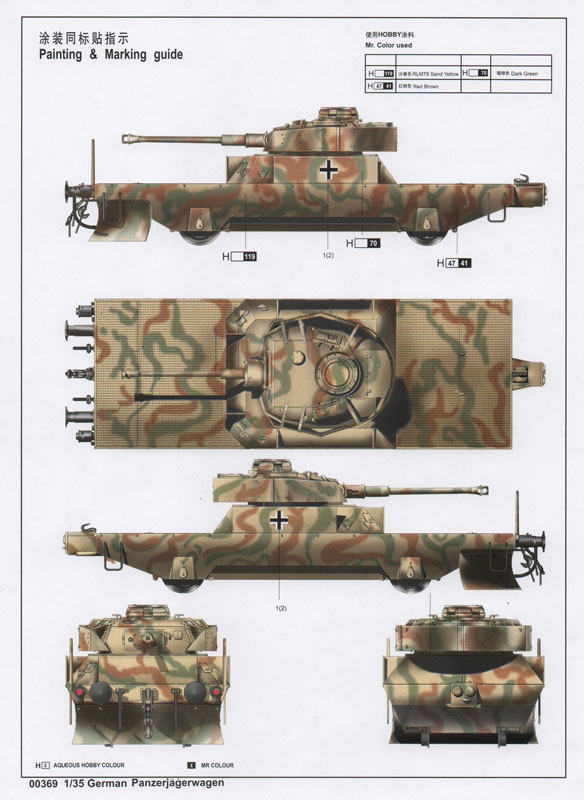
5 views of the PanzerJägerwagen
The specific railroad car was thus developed for the BP44 armoured trains of the wehrmacht deployed on the eastern front. On paper, 22 were made for the 11 BMP 44 (N°73 to 74), and possibly more to retrofit the BP 42 trains still in service (so about 11 more). Still in theory, up to 44. However many trains only had a single PanzerJägerwagen IV due to the lack of resources, especially after 1944. Not all BP 42 were also upgraded with these. So in the best case scenario, perhaps 30 of these railway carse were ever built.
Technically, they were unpowered, but generally placed at the head of the train. Thus, due to this, they were fitted with a massive plough, usable in winter conditions to push out the snow, but also any obstacle, fallen tree or partisan-made barricade. Essentially they also were a less flexible, but better protected variant of the simple open cars in which a Panzer 38(t) could be installed.
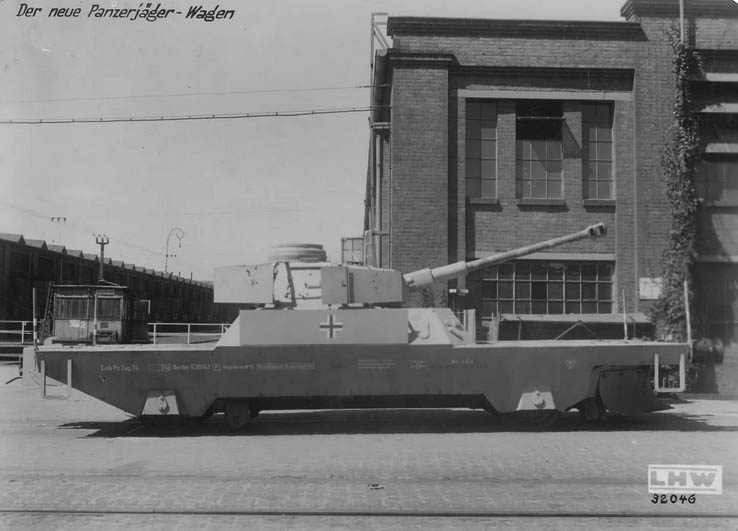
Interesting Factory photo, clearly stating "panzerjäger-Wagen". The "new" one (presumably the Pz 38(t) was the old one.
The armour tailored for these PanzerJägerwagens was tailored to create a casemate around the turret. Indeed the former tank hull was not reused. Only turrets, for which a tailored ring mount (manufactured at the same plant as the turrets) which was welded or bolted on the roof of this "hull". The later comprised a lower part covering the bogies, sloped, with cutouts fore and aft making it edgy, and an upper part that comprised a prismatic base surrounding by add-on armour panels of various compositions. They can be opened for the crew to more easily access the turret. Generally, the two forward panels could be opened.
The forward part of the casemate had sight slits as the loading crew can seat in it, and access ammunition. Since the internal space freed was larger than the original hull, freed from the clutter of an engine and transmission, far more shells could be stored inside. There were several versions of it ranging from the most basic tub-and-turret assembly straight from a tank to the one with add-on Schürzen armour.
The turret was the one from a Panzer Ausf H, of which the production by late 1943 was the largest of all versions. The turret was a bit simplified: It lacked a turret visor and rear positioned pistol ports were removed together with the signal port. However this turret was fitted with the best tank gun of the whole serie, the 7.5 cm Kw.K. L/48 long gun. Compared to the L/43 of early Ausf.Gs, it had better anti-tank capabilities, able to defeat at 1 km range, 85 mm of armor at 30° with AP rounds. It is dubious tungsten rounds were provided to these PanzerJägerwagen, being already in high demand and short supply.
It is possible however these were provided with hollow charge rounds able to penetrate 100 mm regardless of range, but flying at 450 m/s. Since the original tank had 87 rounds, it is likely the more spacious PanzerJägerwagen could house more than 100. As for protection the turret was always shown in photos with the 5 mm thick skirts Schürzen add-on armour, to detonate rocket-powered projectiles. In addition to the main gun, the turret had one 7.92 mm MG 34 coaxial machine gun with spare belt sacks 150 rounds each for a total of 3,150 rounds. And there was the Fligerbeschussgerat 43 type anti-aircraft mount on top of the command cupola, albeit it was omitted of the PanzerJägerwagen, as the BP 44 was already well protected by FLAK.
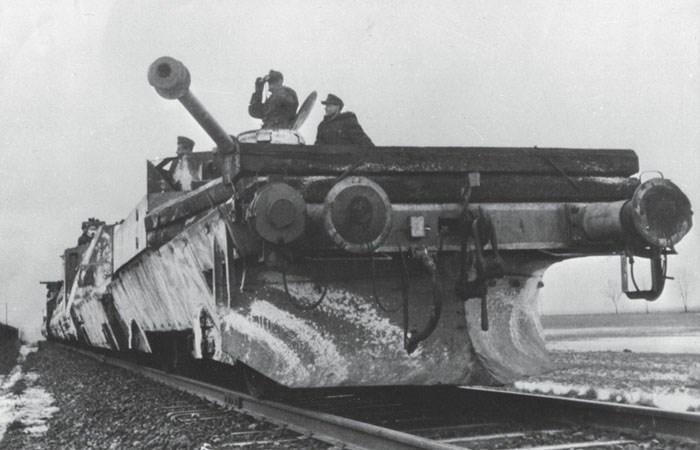
In winter camouflage, with improvized washable white stripes.
Unlike for the original Panzer IVH, the crew of a PanzerJägerwagen IV was limited to three, The Commander, gunner and loader. There was a few variations between these units, some having for example an utility storage bin for rounds and/or personal effects at the back of the carriage. The latter also had steps for the crew to climb in, on both sides. As for camouflage, it seems none was painted with the early standard dunkelgrau (green-grey) bu the new factory applied dunkelgelb (beige) and painted in the field with the usual "röt" or dark brownish red and olive green patterns. In winter as shown in photos, some washable paint could be applied, in full or partial stripes. One Panzerjägerwagen was also used by the Czechoslovak army, called OV vz.45.
Illustrations and photos

A typical Panzerjagerwagen in summer camouflage.
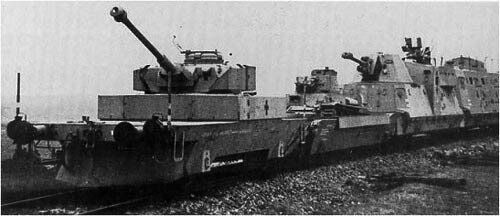
PzjgWg and Panzerträgerwagen ATG-7 Pz 38(t) carriage
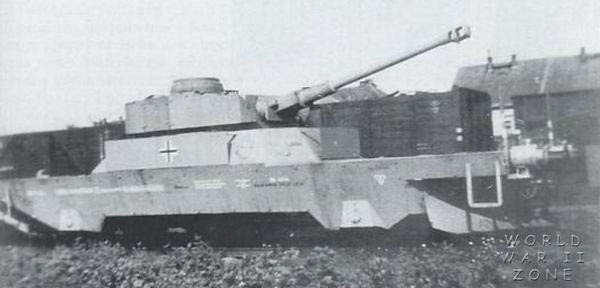
Factory fresh PzjgWg without camouflage
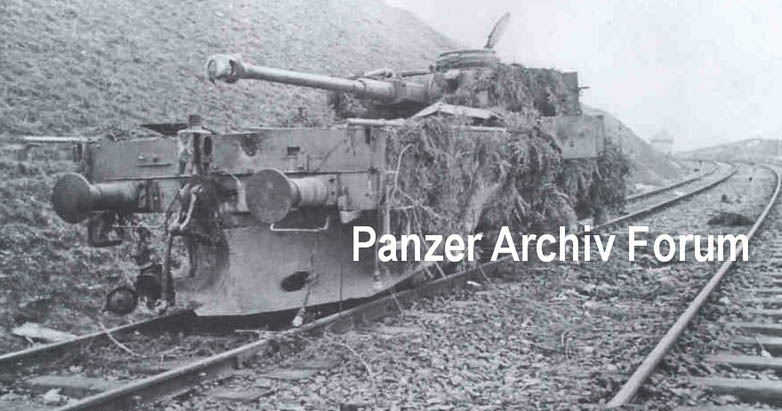
Heavily camouflaged,abandoned PzjgWg
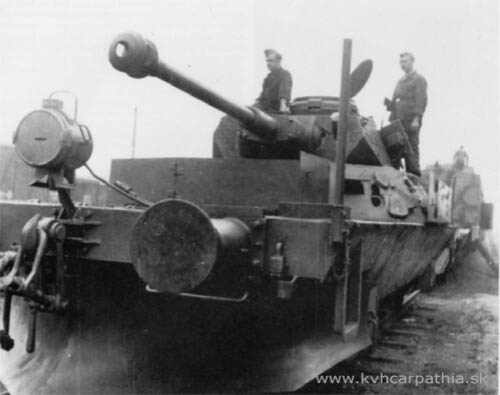
Front of a PzjgWg, showing its plough
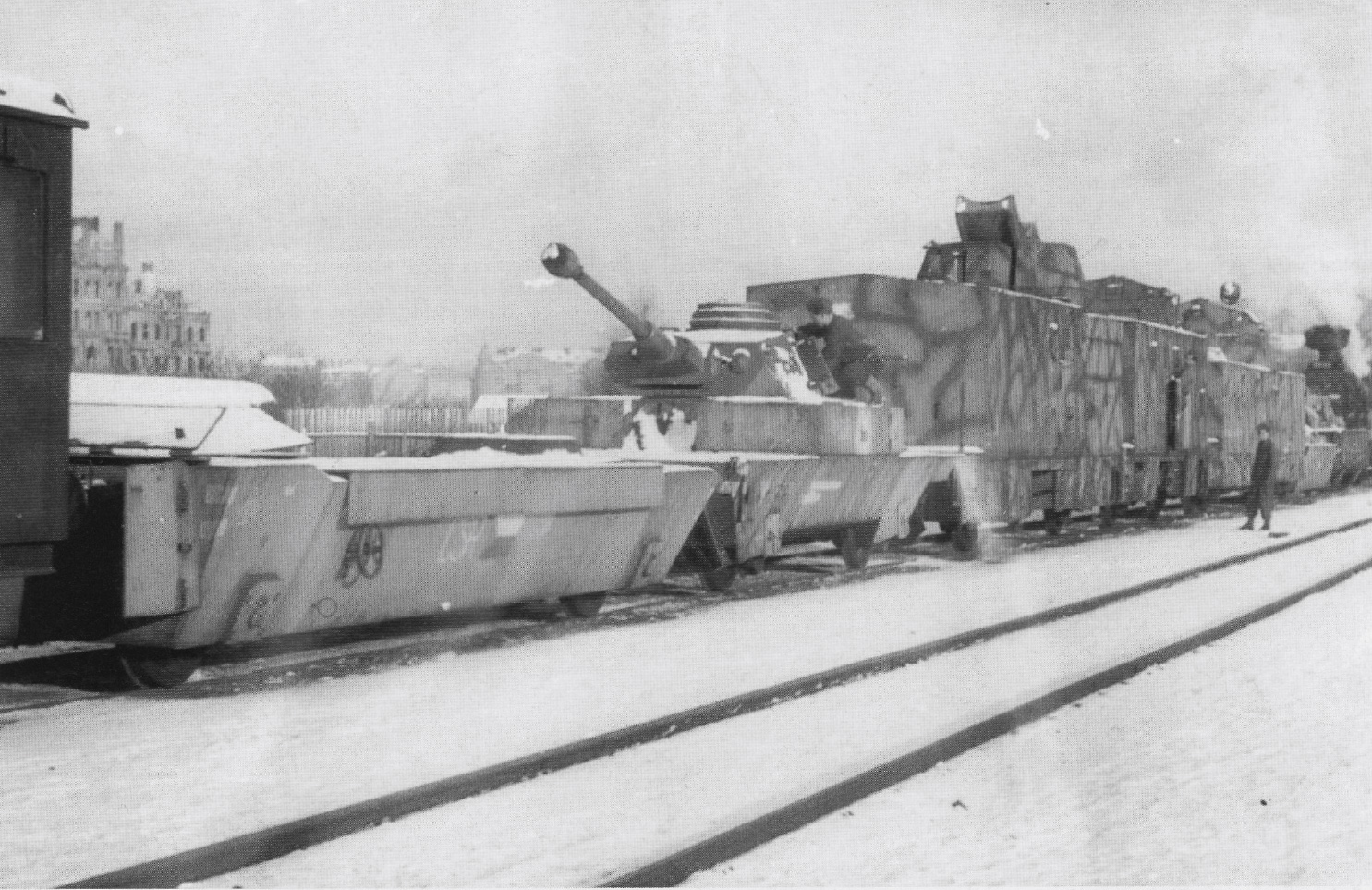
Unusually the PzjgWg was placed further inside the train, like here.
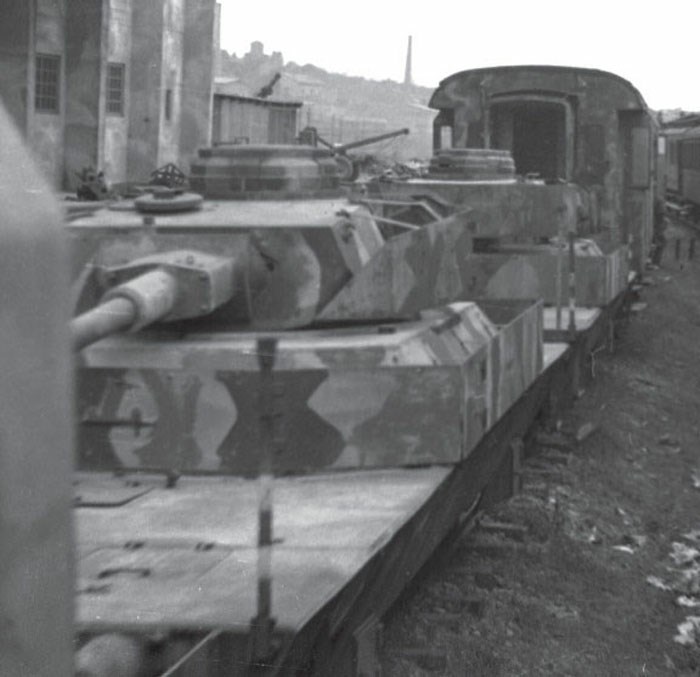
In station, note the camouflage and the schürzen panels clearly visible around the casemate.
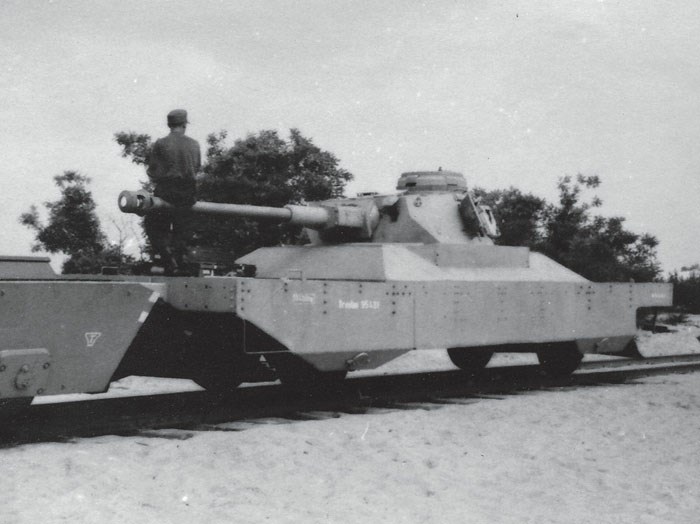
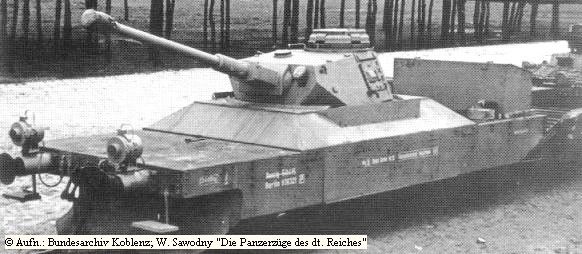
PzjgWg showing its casemate without Schürzen
Sources
EK-Verlag - Die Panzerzüge des Deutschen Reiches 1904 - 1945.Wydawnictwo Militaria - 020 - Panzerzuge I.
Wydawnictwo Militaria - 026 - Panzerzuge II.
Osprey - New Vanguard - 140 - Armored Trains.
Panzer Tracts No.4 - Panzerkampfwagen IV.
Schiffer - German Armored Trains in World War II.
Schiffer - German Armored Trains on the Russian Front 1941-1944
armedconflicts.com
modellbaufreunde.ch
tanks-encyclopedia.com/ww2/nazi_germany/panzer_iv_ausf_h
panzerbaer.de/units/wh_bp42-44
TE 12-2cm-fk-r-auf-gw-lorraine-schlepper-f.php
ipmsdeutschland.de
- Baldwin Railroad battery 1861
- No 6 Garrison Arm. Train 1894
- Ladysmith Train 1899
- Crewe Works 1915 coastal train
- French mobile artillery battery (1914)
- Royal Navy armoured Train 1914
- Regia Marina Arm. Trains 1915-18
- Ajmer arm. trains 1916
- Hungarian MAVAG train
- German Panzerzug Ost (1916)
- Bolshevik Armored Tram 1917
- Finnish Arm. Train (1918)
- Zaamurets (Orlík, BP-4, Lenin)
- Khunkhuz
- General Annenkov
- Yenisei
- Amur
- Terek
- Don
- Dywizja Syberyjska trains 1918
- Kozak
- Piłsudczyk
- PP3
- Gromobój
- Pionier
- Śmiały
- Lis-Kula
- Hallerczyk
- Stefan Batory
- Generał Iwaszkiewicz
- Chrobry
- Wilk
- Danuta
- Poznańczyk
- Kaniów
- Zawisza Czarny
- Zagończyk
- Paderewski
- Mściciel
- Reduta Ordona
- Huragan
- Podhalanin
- Bartosz Głowacki
- Pierwszy Marszałek
- Groźny
- Śmierć
- Śmigły
- Stefan Czarniecki
- Generał Sosnkowski
- Putilov armoured trains
- Izhorskiy Armored Train
- Czechoslovak Legion Trains
- Estonian Trains
- Lithuanian Trains
- Zhang Zongchang Train
- Danuta
- Poznańczyk
- Generał Sosnkowski
- Paderewski
- Śmierć
- Pierwszy Marszałek
- Piłsudczyk
- Śmiały
- Groźny
- Bartosz Głowacki
- Smok Kaszubski
- Drezyna R
- Drezyna TK/TKS
- UK dywizjon Trains
- SOK Draisines 1945
- Arm. draisine Crochat
- Austro-Daimler Draisine
- Armoured draisine Tatra T18
- MBV-2 Rail cruiser
- D-2 Draisine (MBV-31)
- D-37 Draisines
- Krasnaja Zvezda (KZ-1)
- D-3 Draisines
- BTD heavy Draisines (5)
- CB-1 Draisines
- DT-45 Draisines
- BD-41 Draisines (12)
- BA-I-Zhd Railcar
- BA-6ZhD Railcar
- BA-20ZhD Railcar
- BA-10Zhd Railcar
- VS-60 Train/Wagon
- BP-35L/H Train
- NKPS-42/Wagon Train (40)
- PL-35 Arty Wagon
- PL-37 Arty Wagon
- PT-35 Arty Wagon
- KV-1 Arty Wagon
- Crimean 76mm univ. Wagon
- "Tank" Wagon
- BP-42 Train/PL-42 Wagon (10)
- BP-43 Train/Wagon (54)
- 7.62mm Maxim SPU-BP Flak wagon (28)
- 37mm PVO-4 FLAK Wagon (120)
- OB-3 Light Wagon
- 27th Div armoured Trains
- 29th Div armoured Trains
- 48th Arm. Div armoured Trains
- "Stalinets" armoured Train
- "Mir Jafar Bagirov" armoured Train
- "Kozma Minin" armoured Train
- "Dzerzhinets" armoured Train
- "Za Rodinu!" armoured Train
- "Kolomensky Rabochy" armoured Train
- Zenitnyy (AA) armoured Trains
- Goering's Asien
- BP42 armoured train (full)
- BP44 armoured train (full)
- Panzerjägerwagen BP44
- BR 52, Steyr Schwerer Schienen Panzer
- Schwerer gustav Train
- P204(f) rail tank
- Schienenkampfwagen SK 1
- Schwerer Spähzug (s.Sp.) Artilleriewagen
- LeichteSchienenkampfwagen 43
- Zeppelin Panzer Draisine
- Panzertriebwagen N17
- Panzertriebwagen N16
- Panzer Draisine Funkwagen
- Panzerdraisine/Pz.III turm
- Panzerdraisine/Pz.IV turm
- Panzer Draisine Le.Sp.
- Panzer Draisine Flakvierling
- S.Panzer Draisine Kugelblitz
- L2670 leichtes panzertriebwagen
- AB Ferroviana
- Littorina OM 36
- LiBli 42
- Type K2 Steam Locomotive No.134
- Type C56 Steam Locomotive No.31
- Type 90 240 mm Railway Cannon (Futtsu Cannon)
- Type 91 Broad-gauge Railroad Tractor (So-Mo)
- Type 94 Armoured Train
- Type 95 Armoured Railroad Car (So-Ki)
- Type 98 Railroad Tractor
- Type 100 Railroad Tractor
- Type 2598 Railroad Car
- Rinji Soko Ressha 1933
- 1940 coastal defence Trains
- Royal Armoured Corps Trains
- Romney, Hythe and Dymchurch Train
- Malaya Arm. train 1942
- 101-104. sz. páncélvonat
- Finnish Winter War Train
- Croatian Armored Train
- Can. Aleutian No.1 Armoured Train
- Slovak resistance armoured train
- Iraqi armoured train (1941)
- Polish 1945-55 trains
- Arm. train La Rafale 1948
- Tren Blindado 1958
- Panser Rel V16 (1955)
- White Train 1957-87
- RT-23 Molodets ballistic wagon
- Trans-Siberian Arm. Train 1970
- North Korean Arm. Train
- Krajina express 1990
- Volga (2022)
- Baikal (2022)
19th Cent. Trains
WW1 Armored Trains
 Poland
Poland
Interwar Armored Trains
WW2 Armored Trains
 France
France
 Austria
Austria
 Czechoslovakia
Czechoslovakia
 USSR
USSR
 Nazi Germany
Nazi Germany
 Italy
Italy
 IJA
IJA
 UK
UK
 Others
Others
☢ Cold war Armored Trains
References
blog.railwaymuseum.org.ukarmedconflicts.com Russian Trains
warhistoryonline.com
feldgrau.com ww2 german trains
cuttersguide.com
wikipedia.org/wiki/Armoured_trains_of_Poland
derela.pl/drais
derela.pl/tatra.htm